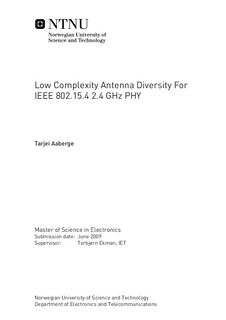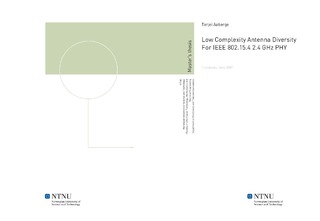| dc.contributor.advisor | Ekman, Torbjørn | nb_NO |
| dc.contributor.author | Aaberge, Tarjei | nb_NO |
| dc.date.accessioned | 2014-12-19T13:44:21Z | |
| dc.date.accessioned | 2015-12-22T11:42:17Z | |
| dc.date.available | 2014-12-19T13:44:21Z | |
| dc.date.available | 2015-12-22T11:42:17Z | |
| dc.date.created | 2010-09-04 | nb_NO |
| dc.date.issued | 2009 | nb_NO |
| dc.identifier | 348869 | nb_NO |
| dc.identifier.uri | http://hdl.handle.net/11250/2369454 | |
| dc.description.abstract | This thesis investigates the obtainable performance improvements associated with different fading mitigation techniques using spatial antenna diversity applied to the IEEE 802.15.4 2.4 GHz PHY. The standard possesses modulation properties that inherently provide some multipath resistance. Further resistance is believed obtainable due to the bad and unpredictable fading environments found in typical areas of application. Potential performance increases were theoretically analyzed for different fading channel statistics when two antennas were available for reception. This analysis provided upper bounds for achievable performance improvements that were promising. Physical testing of selected fading mitigation techniques was performed with hardware from Texas Instruments and means developed by the student. Generally, the PHY has proven itself multipath resistant in the various fading environments tested. PER has been showed to mostly consist of undetected packets. As such, fading mitigation techniques using two receiver chains provide the greatest reduction in PER in a general case, since more packets are detected. PER is observed reduced by a test-dependant factor between 2 and 100 for such techniques. Techniques based on one RF-front end generally provides little performance improvement in dynamic environments, if any. Large spatial differences in received power were observed across distances on the order of a wavelength. A simple technique that switches receiver antenna when detecting an erroneously demodulated packet can exploit this property when RX and TX remain static and hence provide great reductions in PER. This fading mitigation technique is the least complex and power consuming among the ones analyzed and tested. | nb_NO |
| dc.language | eng | nb_NO |
| dc.publisher | Institutt for elektronikk og telekommunikasjon | nb_NO |
| dc.subject | ntnudaim | no_NO |
| dc.title | Low Complexity Antenna Diversity For IEEE 802.15.4 2.4 GHz PHY | nb_NO |
| dc.type | Master thesis | nb_NO |
| dc.source.pagenumber | 95 | nb_NO |
| dc.contributor.department | Norges teknisk-naturvitenskapelige universitet, Fakultet for informasjonsteknologi, matematikk og elektroteknikk, Institutt for elektronikk og telekommunikasjon | nb_NO |

